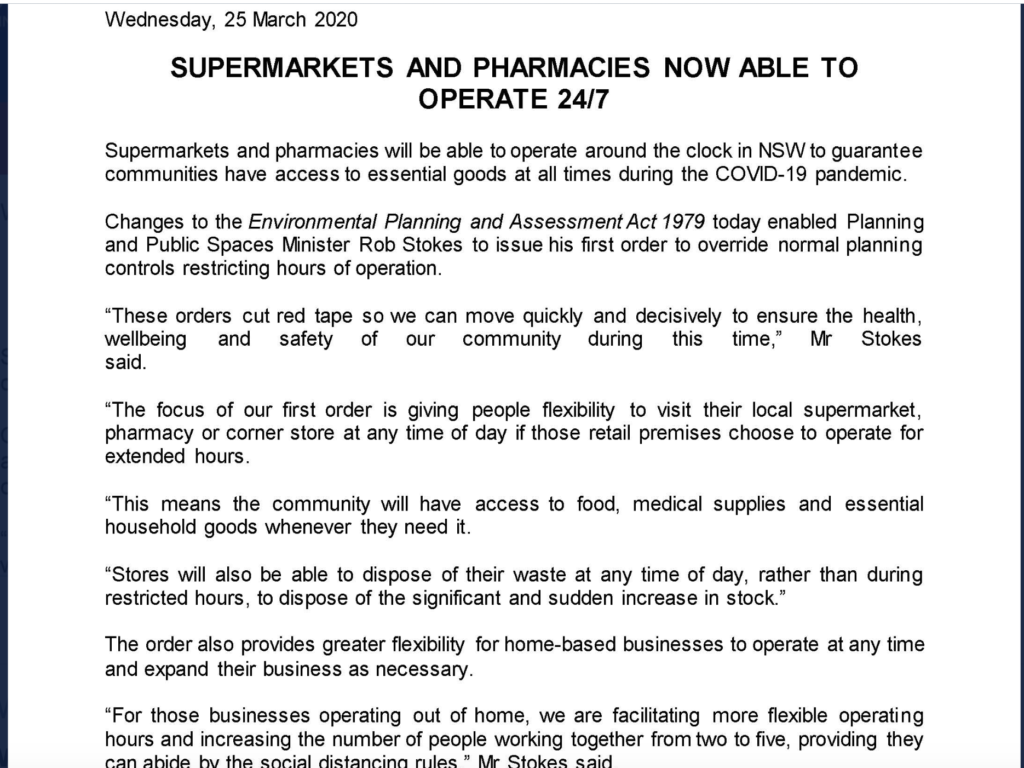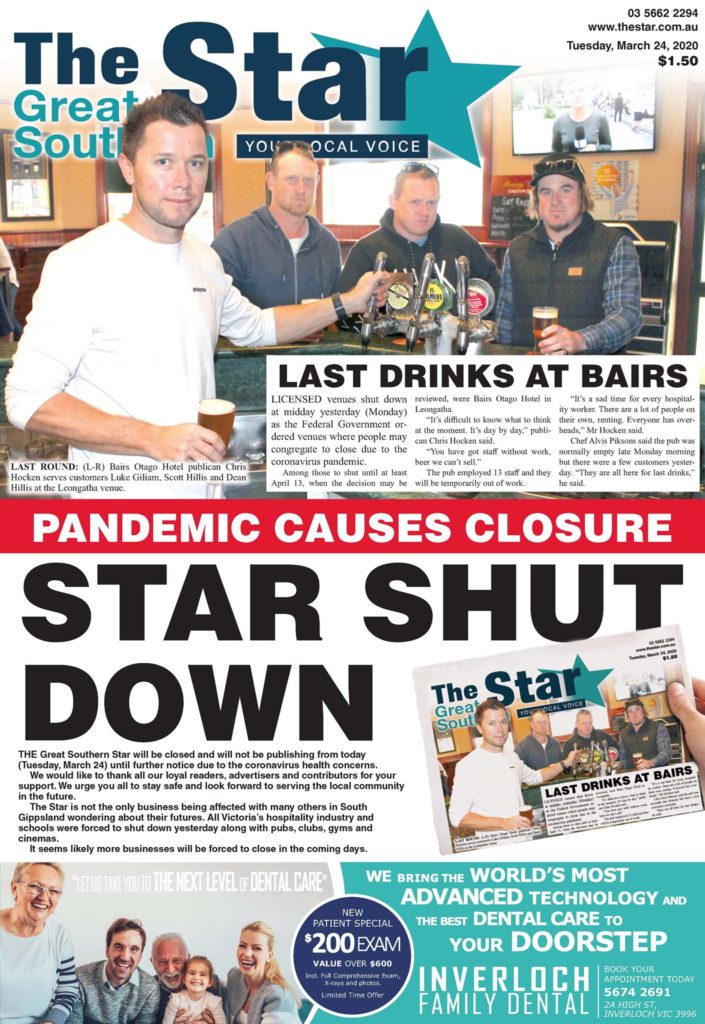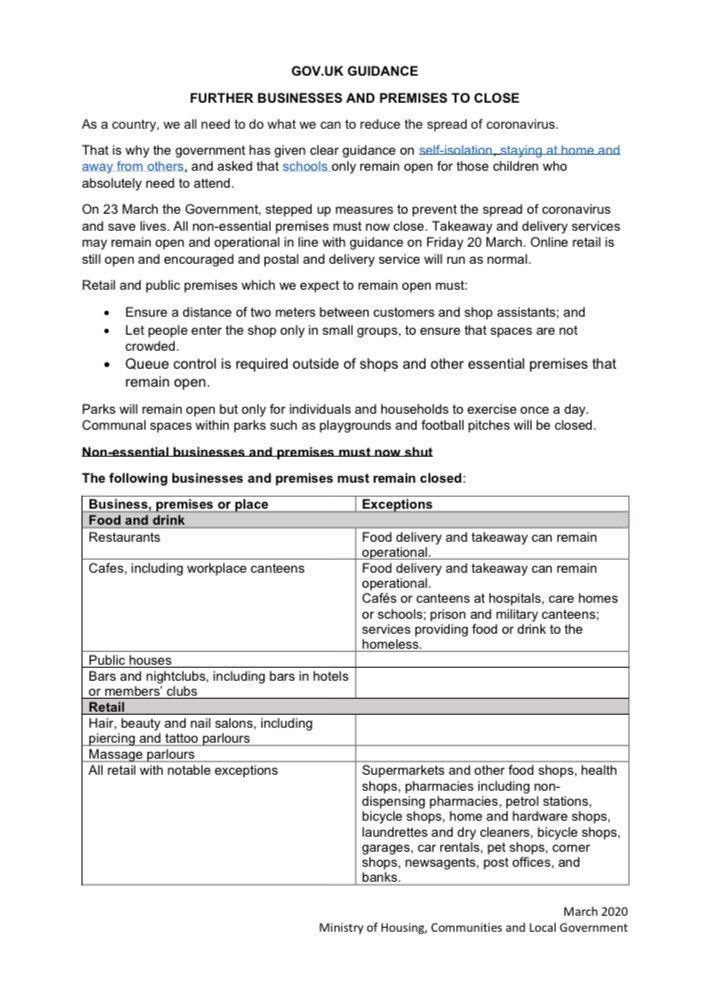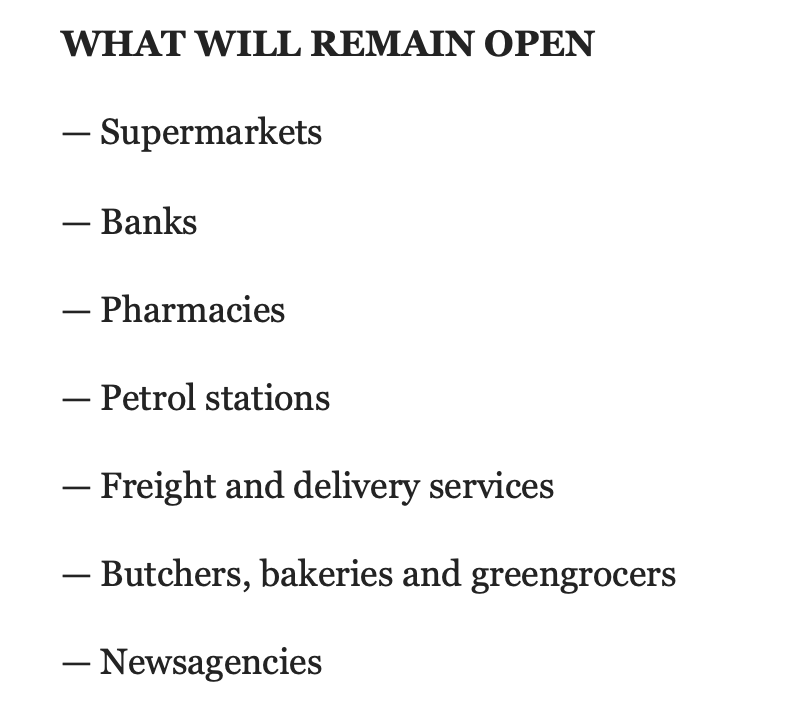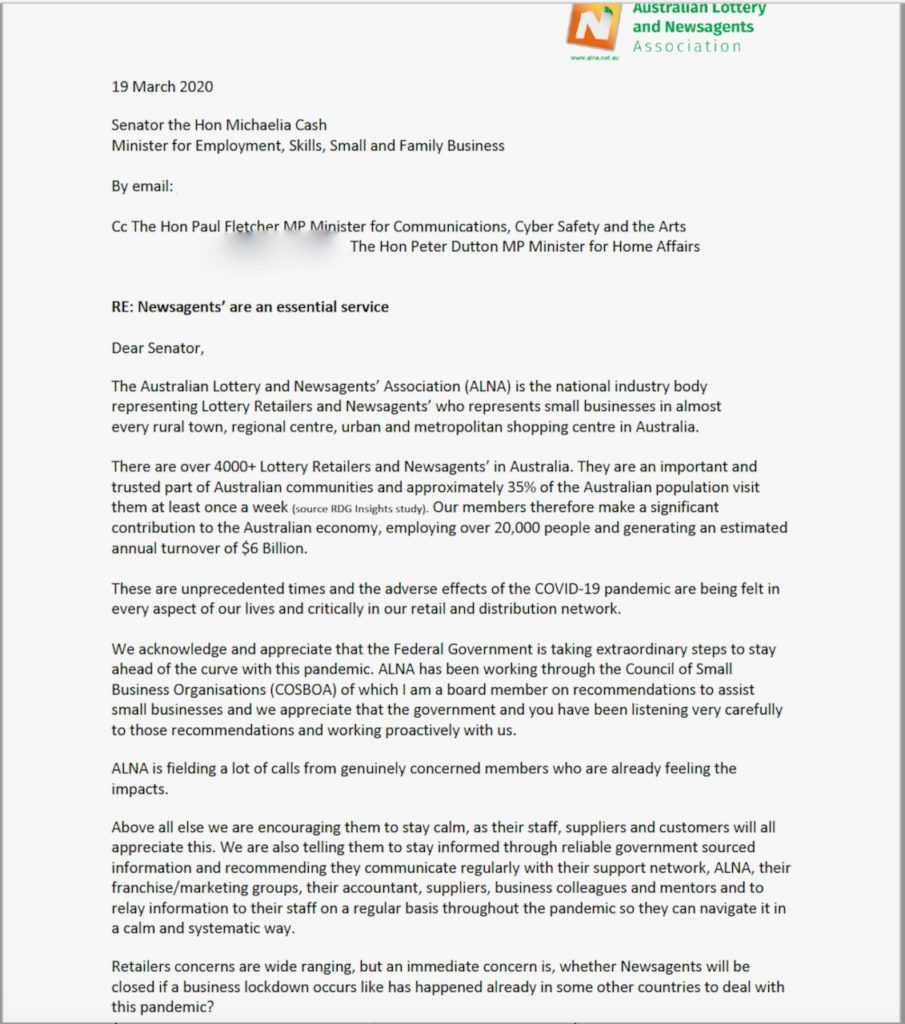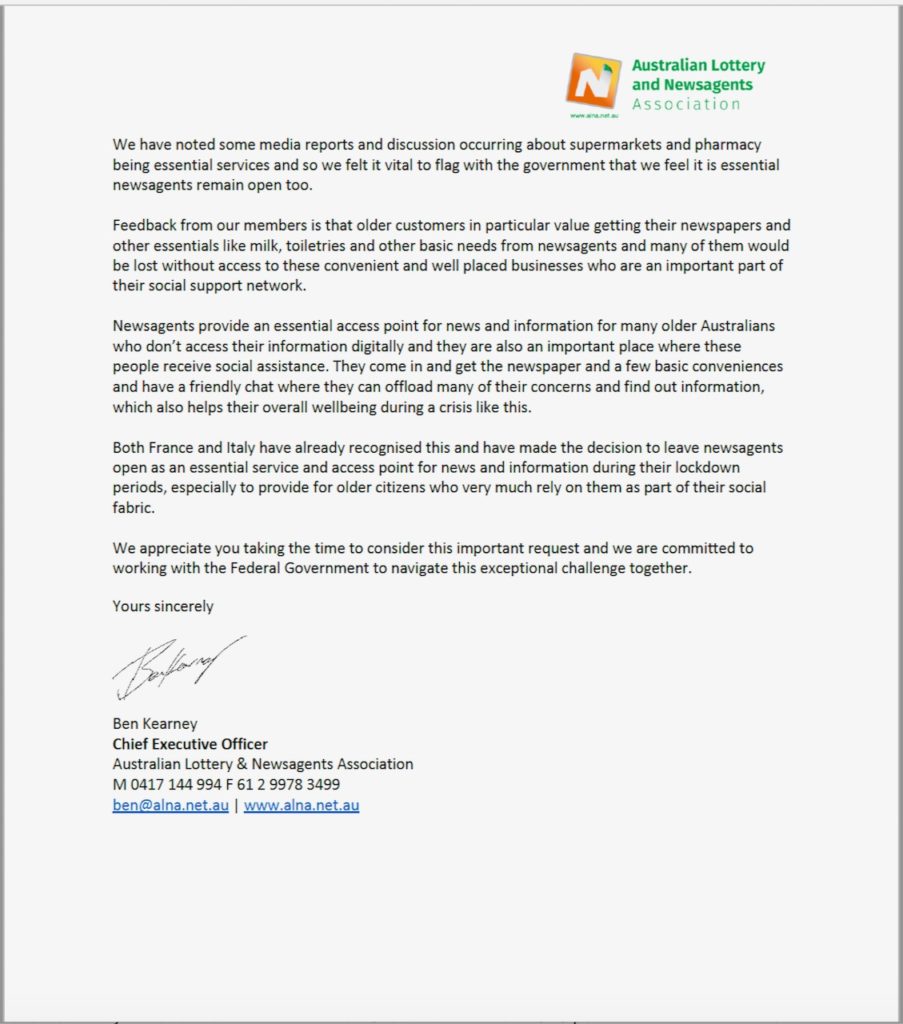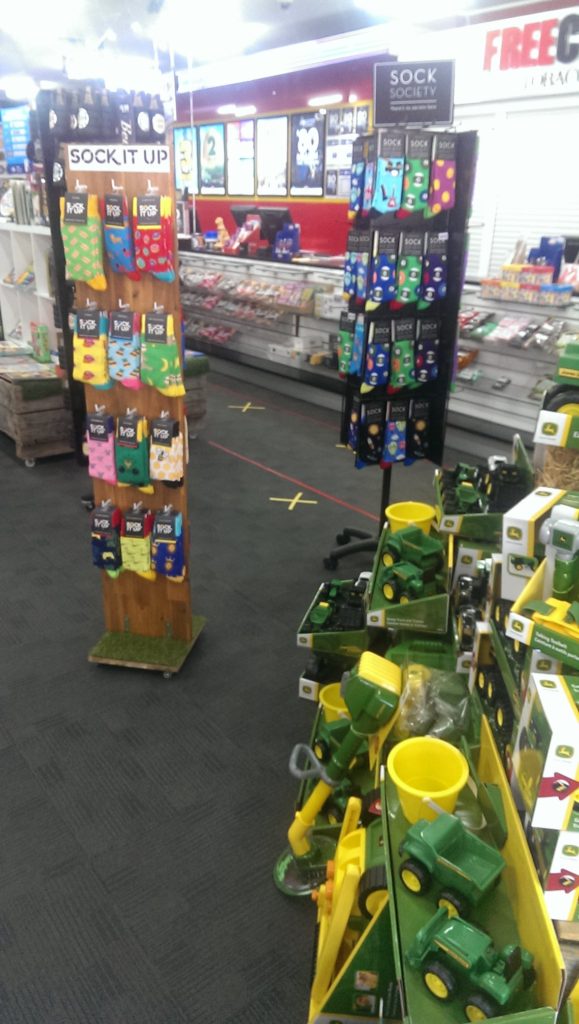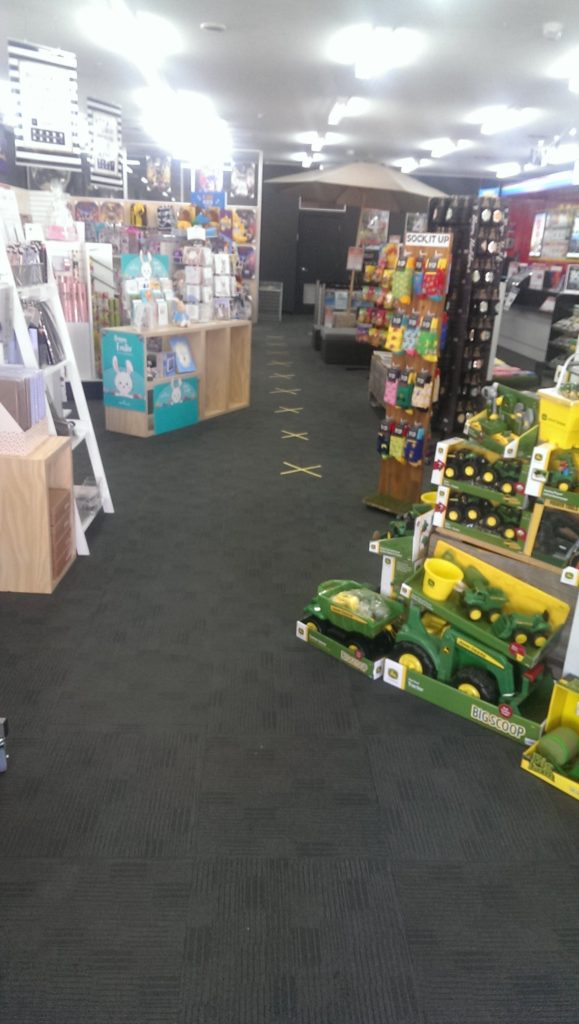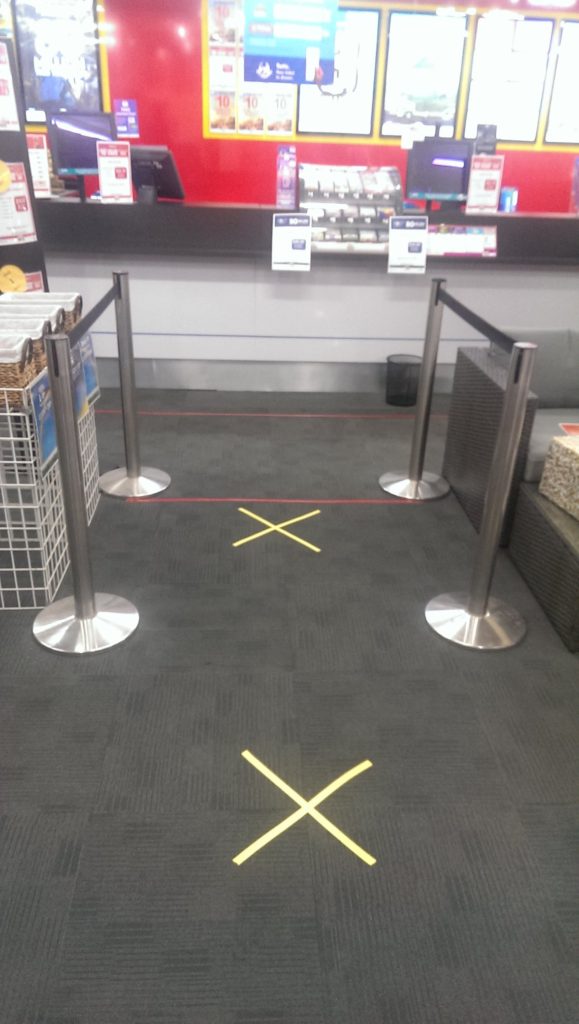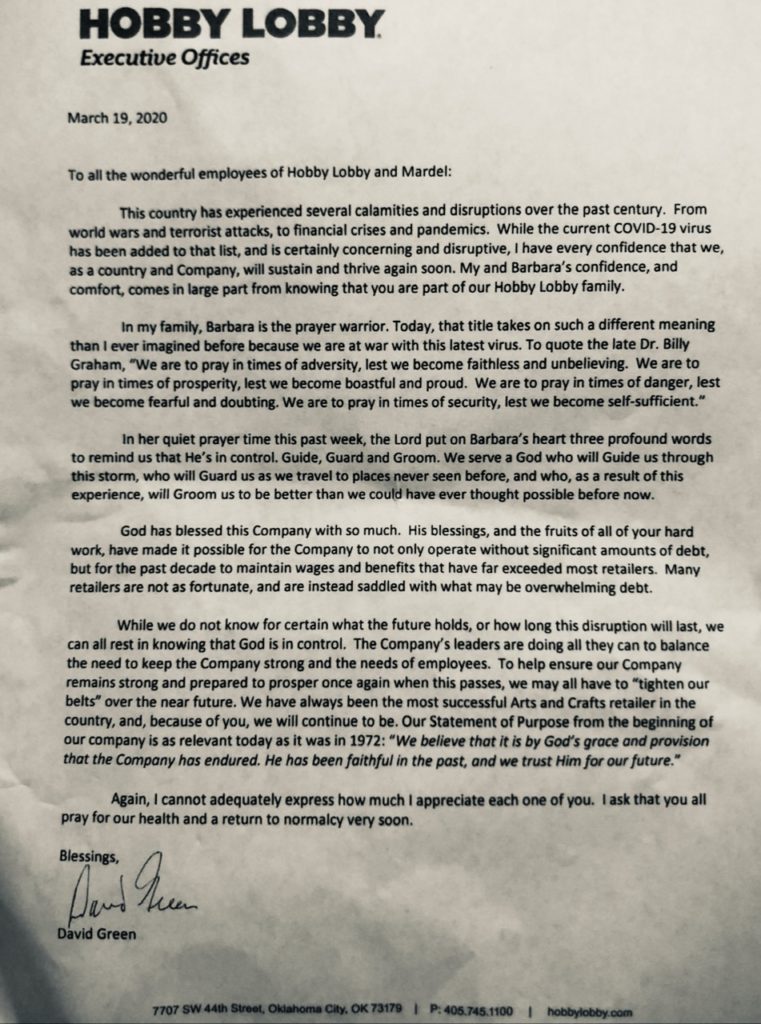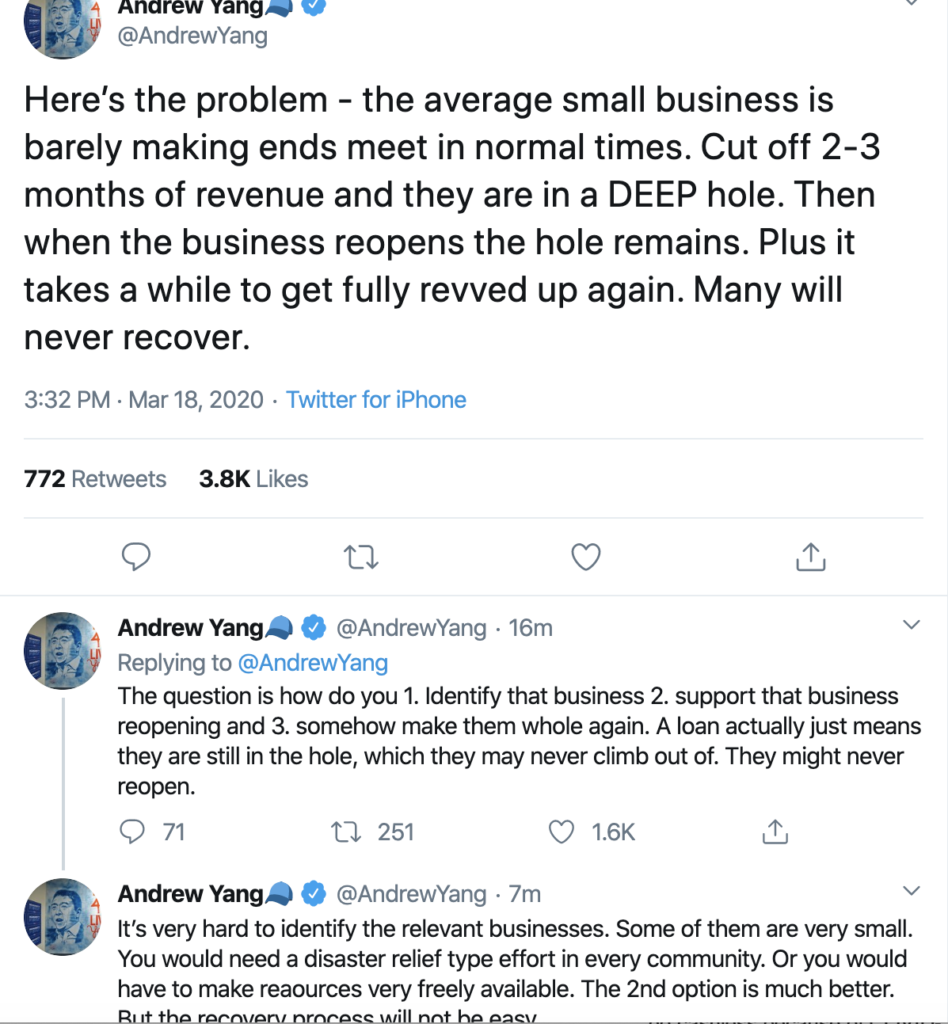COSBOA calls on landlords to be fair in this COVID-19 world
Small land lords time to shine
COSBOA has profoundly congratulated those small landlords around the country who have already cut their rent or in some cases stopped rent for businesses who have no income due to the COVID-19 crisis. We call upon all the small landlords around the country to do what they can for others in distress.
Peter Strong, CEO of COSBOA, stated ‘small landlords are often small business people or families who have invested in property and have rented out to others either as commercial or as residential leases. These landlords may also be experiencing the difficulties of hard times, particularly for those whose income is inextricably linked to the property they lease, such as retired people. Yet, with the announcement from the banks that there is no need for loan repayments for small businesses borrowers for the next 6 months there is an opportunity to pass this saving onto tenants.”
COSBOA knows the pain and anguish suffered by businesses who have no income yet have rent and often wages to pay. Landlords will not benefit from bankrupted business tenants. COSBOA knows that the employees of small businesses are often valued like family and they must be considered for rent relief by residential landlords as their tenant may now be on a lower income, without a job and trying to be ‘Centrelinked’ but are having trouble due to the overwhelming of the MyGov system.
Mr Strong added “it is imperative for every small landlord with a bank loan to contact their bank and get the loan repayment holiday if they are eligible. Then immediately pass that onto their tenants.’
Mr Strong added “any small landlord who takes the loan holiday and then doesn’t pass on that saving to the tenants would be a failure as a person and as a member of our society. The biggest landlords, such as Westfields, Stocklands and the Scentre Group, have shown they are the lowest members of the big business community with their callous callow response to the needs of struggling and closing small business retailers. The small landlords will be no different if they were not to pass on the saving.”
Note for tenants: Not all landlords have loans from banks and may not receive the repayment holiday and may not be able to pass on any savings. Check with your landlord and ask if they have sought to take advantage of the bank repayment hiatus.
Powerball $80M jackpot a test for Tabcorp, lottery retailers and Australians
Typically, today and tomorrow, ahead of the $80M Powerball jackpot tomorrow night, we would see and hear a ton of media coverage about a surge in ticket sales, there would be photos and videos of happy shoppers in-store buying. media reports would be excited, urging on the purchase surge.
Such images would pitch the wrong message in these days.
While we need reports of people purchasing in-store, we need to see stores setup for the required distance between shoppers, recast shop floors that are not cluttered, orderly management for the health and safety of all shoppers and retail business employees.
Lottery retailers should be pitching on social media the ease of safe shopping in-store … anything to hold back what I suspect will be a surge online, enriching Tabcorp at the cost of their retail network.
All of us in business are part of the messaging, especially as plenty of our politicians fail at clear messaging.
We are open for business, offering safe shopping for you, your neighbours and our team members.
Sunraysia Daily newspaper closing
The Sunraysia Daily has announced it is suspending print operations. Expect more news like this.
SUNRAYSIA Daily will suspend printing and all staff will be stood down due to the impact the coronavirus pandemic has had on the business.
Staff were told in a meeting on Tuesday morning.
It was proposed that Saturday’s paper would be the last edition until further notice.
Staff were told the intention was for operations to eventually resume.
The decision affects all of Elliott Newspaper Group mastheads, including Sunraysia Life, The Guardian in Swan Hill and Gannawarra Times.
Sunraysia Daily, Mildura’s only daily newspaper, is in its 100th year.
What to focus on right now in your newsagency
Based on up to date sales data from the week to Sunday, here is a list of the product categories that are working the best in newsagency businesses:
- Newspapers. People are flocking back to the print medium. Home deliveries are up, especially in regional and rural locations. News and Nine are helping newsagents ensure they have stock.
- Magazines. Weeklies, real life and crosswords especially. Now is the time for a front of store pitch. Selling 2 or 3 in a basket is ease.
- Cards. Not right across the board but in many. Interestingly, unit volume per basket is up as people shop ahead. In more than half of all stores I looked at sales were up last week on the 2019 average.
- Jigsaws. A real hero all through March. Front of store is key to this, social media too.
- Everyday plush. The perfect purchase to bring a smile to a kid’s face. Front of store and at the counter.
- Games. I have seen stores go from $200 a week to $800 a week.
- Everyday stationery. What’s working well is packs put together to make shopping easy and to offer ideas for use.
I urge newsagents to recast their business to focus on the changed needs. Making changes around these categories listed and other local growth categories you see demonstrates engagement, a service shoppers will respond to.
AMP writes to tenants in shipping malls
As the advice of health authorities and the respective governments across Australia and New Zealand continues to evolve, I want to keep you informed of the steps we are taking to support you during this period.
We recognise that shopping centres provide essential services including food and groceries, pharmacies and medical clinics and as such, these services will continue to trade as directed by authorities. We recognise the lock-down advice of both countries and are working with retailers on the ground in regards to closing these stores.
We acknowledge that we are in uncertain and unprecedented times and that many businesses are facing significant challenges on many fronts. To assist you, we are committed to flexibility of payment terms and recognise the varying requirements of our retail partners. We’ve already been in touch directly with many of you, otherwise please contact us so we can understand your position in more detail and work with you on your particular circumstances.
For those retailers still trading, our focus is on providing a safe place for people to shop and work, with increased cleaning and signage advising customers of safe hygiene practices, as well as the addition of extra hand sanitising units in high use areas. We’re also keeping customers updated advising of the changing trading conditions.
We continue to closely monitor the situation and will keep our retailers informed as more information comes to hand.
Thank you for your continued support.
Brett Williams
Managing Director, Retail
AMP Capital
Tabcorp writes to lottery retailers
And here is what they said…
Dear Retailers,
Firstly, I hope you, your families and your teams are well.
As you may have seen, late yesterday the Federal Government announced restrictions on indoor gatherings, including pubs and clubs. The New South Wales and Victorian Governments also announced further restrictions aimed at curbing the spread of COVID-19.
We are currently seeking clarity from each government about what these restrictions precisely mean for our outlets.
In New South Wales and Victoria, it is understood outlets in pharmacies, grocery stores, convenience stores and petrol stations will be able to continue to operate. We also believe newsagents may be classified as a “convenience store” and be entitled to continue to trade, however we are still discussing with the relevant authorities in order to have that confirmed. We will confirm this position as soon as we know more. Outlets that fall outside of these types of essential service stores will not be allowed to continue to trade.
In Queensland, South Australia, the Australian Capital Territory, Tasmania and the Northern Territory, there are currently no government-mandated restrictions on outlets trading outside of those restrictions announced by the Federal Government yesterday evening. As you’ve no doubt experienced yourself, this is a swiftly evolving issue.
We understand you will have lots of questions in relation to your business, ranging from whether you can or can’t continue to trade through to fees and charges, Site Surveys and managing Instant Scratch-Its stock.
Our team has been working across the weekend to understand the best path forward in this ever-changing environment and will continue to do so this week. We are investigating each issue as quickly as we can with the latest information available and will provide regular updates and Frequently Asked Questions (FAQs) on the Urgent Information section on Retailers Web’s homepage.
For you and your teams safety, please ensure you are following the current social distancing requirements in your outlet which is available on Retailers Web.
We will also be posting links to information about the Federal Government’s small business support package on Retailers Web.
Many thanks once again for your support at this challenging time.
Best wishes,
Antony Moore
General Manager Lotteries Retail
ALNA lobbying results in progress on newsagencies remaining open
Here is an announcement from ALNA late tonight.
Newsagents to remain open across Australia
- Enabling accessibility of news and information for older Australian and those with limited digital options
- Establishing strict protocols regarding social distancing, cleaning and hygiene
Australia, 23 March 2020, Following on from the Australian Lottery and Newsagents Association’s (ALNA) proactive letter to several Federal Cabinet ministers last week, requesting that they consider Australian newsagents to be an ‘essential service’ and remain open as they have in France and Italy, ALNA is pleased with advice and support we have received from State and Federal governments that newsagents can remain open at this time, while managing their responsibilities carefully.
ALNA was contacted today by the Deputy Prime Minister, Michael McCormack, who acknowledged the advice we had provided government regarding newsagents and their role in the Australian community. He reassured us that the government made efforts yesterday to provide greater clarity for all small businesses, including our members, around which businesses were closing.
ALNA understands how complex these issues are and we appreciate the government alleviating members concerns and providing greater clarity for all small businesses including our newsagents. We want to be a strong role model for other businesses in managing social distancing and helping to educate the public about this, all the while continuing to deliver hard copy news and some of life’s basics. In particularly supporting our older generations who rely on newsagents for their convenience and to many others who either don’t have ease of access to digital news or whose preference is for hard copy news.
Ben Kearney, CEO, Australian Lottery and Newsagents Association, stated “With strict cleaning protocols, personal hygiene and social distancing rules in place, and limiting how many customers can be in store at any given time, it’s undoubtedly not business as usual, however we are working hard to innovate our service delivery and this announcement from the Government provides certainty, for now, to our newsagents as to their continuity of trading during these challenging and unprecedented times”.
Newsagents are also in a strong position to alleviate pressure on supermarkets and local grocery stores, as many provide food and beverage items and other important household items. And with school children still either attending school or being home schooled, having access to a wide range of stationery and school supplies will be a relief for parents and carers as well.
What shops will remain open?
Victoria is leading the country on mandated business closures. While the state government is yet to issue a specific list, here is what The herald Sun has published:
Given the objective of the shutdown, to reduce contact, businesses selling daily necessities and where people are likely to move through and purchase are preferences.
I urge newsagents to look at the post yesterday showing one way to mark our appropriate distancing on the shop floor.
A challenge to magazine deliveries in Victoria tomorrow
Ovato has advised that a truck to Victoria has broken down. For the weeklies, it is expected that metro will still be able to make on-sale, but Country Vic won’t be on sale until Tuesday.
Retail trends of note in a COVID-19 impacted world
I wrote this note to customers of my POS software co. yesterday and thought I’d share it here as it talks to some of the opportunities we are seeing, opportunities some newsagents are already leveraging.
We are grateful for the terrific insights shared with us by many retailers across multiple retail channels and in a variety of situations. These insights have enabled us to put together the following to share with you.
In the last week we have run 8 video conferences for retailers. These have provided terrific insights. We have also participated in teleconferences with suppliers to retailers. Collating all we have heard has helped create what we share here.
COVID-19 is not impacting retail in a uniform way. The differences present opportunities that can be leveraged…
- Regional and rural businesses are less impacted. More than 100 retailers in three different channels report an increase in sales in the last week. We think this is because people working from home are doing it from holiday homes and country properties. Some have moved back with family for the duration.
- Large shopping centre businesses, except for supermarkets, are in a world of pain. [Note: I wrote this email Saturday mid afternoon. At 4pm that day I got an email from one of my own shops in a Westfield centre and sales were almost double what we had been expecting. Plush, for example, hit $771.00 for the day, which is up for a Saturday. So, there … hmm.]
- Suburban high street retail results are patchy. Some good news but mainly declines.
- Some previously challenged categories are performing well – newspapers and magazines are having a terrific sales surge. In the magazine space, crosswords, real life, gossip and relaxation related titles are doing particularly.
- Games and jigsaws are hero product categories. Some of the more recent release games are doing particularly well. To balance this, we’ve been told of a slowing in outdoor related games.
- Everyday plush, sub $20, is performing well, delivering terrific growth. Beanie Boos, for example, are doing very well.
- Everyday stationery is doing well – pads, pens, pencils, rulers, staplers, folders … as people work and learn more in the home.
- Some fishing outlets have reported growth in sales of fishing gear.
- Gift shops, jewellers and homewares businesses have reported significant declines.
- Online, as mould expect, is surging. This is including click and collect / curbside pickup.
We have seen several retailers switch to cashless in the last few days. None is reporting customer pushback.
The retailers who have made significant front of store moves to serve the new needs and interests of shoppers are reporting good responses. Games and jigsaws are a good example of this.
Some retailers are having success bagging up packs and offering these as a bundle to shoppers. They make the shop faster and even facilitate curbside pickup or home drop-off.
With nursing homes all but closed to visitors, some retailers are having success delivering care packages for loved-ones who cannot visit.
These are all opportunities.
Looking back in our own software business, we have received a bunch of orders for new websites as retailers make this move. We have redirected resourced to deliver these quickly, efficiently. There is no doubt that being able to sell online has come into its own through this situation.
The other thing we are noticing is that plenty of retailers are taking the opportunity to work on their business. This is keeping our sales people busy, demonstrating our software online and bringing on new customers.
What are we seeing in retail in retail in this COVID-19 world?
The video conferences I have been hosting with newsXpress members and Tower Systems customers have revealed some interesting and, hopefully, useful data. We are hosting these conferences daily.
Most regional and rural retailers are either up or in line with 2019 trading whereas most city retailers are down with shopping centre retailers down the most. On a video call late Thursday, of the 25 businesses, 16 were regional and rural across five states and all reported solid trade.
I have heard regional and rural retailers reporting that the better conditions are due to people with holiday homes or hobby farms and the like relocating to work from these during this work from home window.
There is also evidence of city people moving in with country located relatives.
In city high street situations there is a slight decline with offices emptying out. The shopping centres are in the most challenging situation with declines of 40% and more now common.
In the regional and rural locations stationery is selling well as are colouring books, especially adult colouring.
Across the board, popular items include jigsaws, games, crossword puzzles, magazines, basic stationery and everyday value plush.
We have been promoting send a hug to pitch cards with modest success.
Thursday, newsXpress kicked off an online brighten the room / send a hug Beanie Boo promotion offering 25% off and free shipping triggered at $50. This has driven a terrific boost in online purchases.
I think it is prudent that there are no rep visits to stores at all. It is best to keep shops for shoppers. Cash is king. I can’t see many orders being placed unless for items that will sell well in the short term. rep visits right now are a distraction.
Likewise, I think card companies need to reconsider merchandiser visits.
Retailers are not thinking beyond COVID-19. I think all bets are off for traditional promotions. Take Mother’s Day, for example, plenty of retailers have said they will not bring in additional gift stock for this and that they have cancelled later in the year seasonal orders.
Operating costs. We have had success helping some newsXpress stores to reduce rent. The most successful is a regional NSW store where their landlord has agreed a 50% reduction for at least 6 months. This was achieved using a template we developed a week ago for newsXpress members.
Urgent proposal to Tabcorp
Here is a proposal I put to Tabcorp early this morning following Powerball jack potting to $80M last night:
I write on behalf of newsXpress members as well as the 1,700 newsagent retailers using the Tower Systems POS software.
We are concerned that the $80M Powerball jackpot will prove to be challenging for retailers impacted by restrictions such as no gatherings of more than 100 people, nursing home access in or out, offices emptying as people work from home and entertainment precincts that are shut down. We also expect sales will be a challenge in shopping centres where traffic is down significantly.
We propose urgent, and by urgent we mean today, consideration of:
- Relaxing your rules and allowing retailers to pre-print tickets so they can be taken and sold offsite, such as in a nursing home or at the front of the shop to people who do not want to enter the shop. This relaxation of rules could be limited to 7 days to mitigate any concerns within the company about abuse.
- Releasing to Tower Systems and any other channel connected software company your API along with approval to develop an online sales ability for local stores to sell lottery tickets to regular / local shoppers. We anticipate that Tabcorp has an API for securely accessing the vending of tickets.
While this may challenge your OzLotteries relationship, as a shareholder inn that company I expect Tabcorp could prevail.
Should you release the API and permit existing Tabcorp franchisees to sell online, we would fast track this development for retailers for any individual store website. We would also look at a group wide solution for newsXpress members and urgently work on it if it possible.
I am concerned that in locations where traffic is down because of COVID-19, regular shoppers in those stores will try your website or app, establishing the risk of migration of that shopper from in-store to online.
Join in and talk with other retailers about COVID-19 opportunities and challenges
Tower Systems is hosting another open to all online meeting for retailers to discuss matters relating to COVID-19. All retailers are welcome to participate.
Time: Mar 20, 2020 10:00 AM Canberra, Melbourne, Sydney
Join Zoom Meeting
https://zoom.us/j/911896341?pwd=aWhiT2J6Wmp0bWd3ZEpyZFNQQlRVdz09
Meeting ID: 911 896 341 Password: 393145
Click here to see a video of the meeting from yesterday. This is the fifth online meeting with retailers already this week. Each meeting is different. From what people say afterwards, the most significant takeaway is comfort from talking about a shared experience. None of the sessions have a sales element.
GNS update on COVID-19
Here is a statement from GNS regarding COVID-19:
Dear Customers,
I wanted to take the time to write and let you know where GNS is at given the rapidly evolving COVID-19 situation and how we are looking after our people and you, our customers.
GNS remains open for business, and both product supply and deliveries are running smoothly. However we are taking extra precautions in order to help protect our team, our customers and the wider Australian community.
Changes to warehouse operations
One of the initiatives we are implementing is the temporary suspension of the ability for customers to pick up goods from our warehouses. We’ve done this to protect our customers and warehouse team and to help ensure that we can continue to offer uninterrupted delivery to all of our customers across the country.
Pick-up orders received prior to 2pm today will be available for pickup tomorrow, but must be collected by close of business tomorrow.
New pick-up orders thereafter will no longer be possible until further notice, and any orders placed as such will be treated as a delivery order.
Suspension of open days and in-warehouse shopping
For similar reasons, we have also suspended all GNS customer open days and the ability to shop/browse in-warehouse, effective immediately. We hope to be able to resume these in the future, as the health situation allows.
Changes to sales team call cycles
Our field sales team will now be working remotely rather than making face-to-face calls on the road, moving to primarily telephone and email contact with customers. Your usual state customer service team, account manager and state GM will all be available by phone, email and video conference to support you as needed.
Update on high demand categories
We have experienced unprecedented demand for hygiene-related products and are endeavouring to source product from suppliers to meet this demand and fulfill existing backorders. Under our terms and conditions backorders are firm so, please, if you no longer require items on backorder please let us know as soon as possible.
We’ll keep you updated with any major changes if and when they occur, but in the meantime, thank you for your continued support during these difficult times.
Another online meeting for retailers to discuss COVID-19
Tower Systems is hosting another open to all online meeting for retailers to discuss matters relating to COVID-19. All retailers are welcome to participate.
Time: Mar 20, 2020 10:00 AM Canberra, Melbourne, Sydney
Join Zoom Meeting
https://zoom.us/j/911896341?pwd=aWhiT2J6Wmp0bWd3ZEpyZFNQQlRVdz09
Meeting ID: 911 896 341 Password: 393145
Click here to see a video of the meeting from yesterday. This is the fifth online meeting with retailers already this week. Each meeting is different. From what people say afterwards, the most significant takeaway is comfort from talking about a shared experience. None of the sessions have a sales element.
US presidential hopeful speaks in terms small business retailers appreciate
Sadly, Andrew Yang was knocked out of the US presidential race in the democratic party primaries weeks ago. I say sadly because in my opinion, yang is the type of leader the world needs. he is smart, engaged, inspiring and tech. savvy. Here is a tweet from yang yesterday about support for small business in these challenging days of COVID-19.
ALNA lobbies Tabcorp on behalf of lottery retailers on COVID-19
ALNA CEO Ben Kearney sent out this newsflash this afternoon:
Australian Lottery and Newsagents Association (ALNA) calls on Tabcorp to take decisive steps to protect and support their retailers in navigating the COVID-19 pandemic
As I am sure our members will agree, these are unprecedented and very challenging times and the adverse effects of the COVID-19 pandemic are being felt in every aspect of our lives and critically in the retail network.Above all else we are encouraging our members to please stay calm, as your teams, suppliers and customers will all appreciate this as we are all working hard to navigate the same challenges.
As you would be aware the Federal and State Governments are taking extraordinary steps to stay ahead of the curve with this pandemic and many large businesses are stepping up to do their share of the heavy lifting. Simple measures like ensuring continuity of wages or sick leave for casual employees that may need to self-isolate are helping. Big business has much greater capacity to absorb these shocks than small business operators do and Tabcorp is in a strong position to help.
ALNA is already working with government on ways to help retailers through the crisis and of course in recovery on the other side. This is a great opportunity for ALNA and Tabcorp to work together on this issue with government, as they (the issuers of licences) are significant stakeholders and will ultimately feel the shocks to the retail network over time with a loss of tax revenue, etc.
The fear and panic this pandemic have caused is unparalleled and Tabcorp’s retailers are not immune.
ALNA is making available as much information and support to members during these uncertain and extraordinary times.
As this crisis unfolds ALNA is fielding lots of calls from genuinely concerned members who are already feeling the impacts and are asking if Tabcorp has a plan to support and protect their retail network.
Retailers concerns are wide ranging and start with smaller more immediate concerns i.e. what will happen if the shopping centre closes and I am left with a large amount of unsold syndicate shares, to bigger concerns around what will happen if the shopping centre is forced to close and I have no income for several weeks, or on high streets if players stay home and self-isolate.
The biggest concern of many retailers is the potential for a rapid transfer or dislocation of retail sales over to online as the crisis worsens and more self-isolation measures are adopted or imposed. The new remuneration/omni-channel model does include retailers in omni-channel sales and revenue, but it is not geared to fairly support retailers if an unprecedented and rapid dislocation occurs like this and retailers are left with no mechanisms to sell lottery products to regular customers.
Retailers already report customers are opting to stay at home to avoid the risk of infection. This will potentially be catastrophic for retailers if this escalates through fear or by additional government restrictions on public gatherings and self-isolation, etc. As Tabcorp and many other employers are encouraging and facilitating staff to work from home where possible. This will add to the reduction in retail traffic our members are already reporting.
As you know the new remuneration model has a significant portion of revenue contingent on some performance and compliance outcomes and this is unfortunately adding to the uncertainty and anxiety about cashflow for retailers which is so important to their livelihood at this difficult time. Small business ‘lives and dies’ on cashflow. The failure of cashflow is the single biggest cause of small business closure and consequent loss of employment.
Yesterday, Australian Lottery and Newsagents Association (ALNA) has written to Tabcorp’s Managing Director and called on them to take decisive steps to protect and support their retailers.
ALNA has recommended the following practical measures that will deliver immediate and direct support to their retailers, but importantly they will provide surety and would clearly demonstrate Tabcorp’s support for their retail network in this incredibly challenging and unique time. These will relieve some of the stress and concern being felt by retailers and demonstrate that the whole business is working to resiliently move through this together. They would set a great precedent too for other franchise systems in Australia to follow.
Suspend scoring of the Omni-channel Program for this cycle – immediately (for this Cycle 02/03/2020 – 28/06/2020) suspend scoring the omni-channel program requirements and rate all retailers Green for the Cycle. This will guarantee the commissions from the remaining or available sales are not further eroded and immediately relieve heightened anxiety of retailers.
Support Retailers Revenue – in the event a rapid retail sales decline, business interruption (i.e. shopping centre closures), or the effects of any other forced social distancing measures imposed or being felt in centres and high streets occurs, or where customers simply disengage completely due to illness, Tabcorp should consider temporarily removing ongoing franchise and terminal fees etc. and guarantee retailer’s revenue/commissions for any period the retailers are unable to trade or feel the disproportionate effects of this crisis. This would provide surety and help retailers to maintain quality well trained staff who will be so critical in the rebound phase.
Increase Share of Online/Digital Sales – if there is a rapid and en masse transfer or dislocation of retail sales to online due to mass self-isolations, for Tabcorp to implement temporary measures or mechanisms to re-allocate revenue back to retailers to more fairly share digital revenue during this period which will provide critical and direct financial support to retailers.
Furthermore, ALNA has signalled our desire to work together on what plans or strategies can be prepared now for the retail network when the crisis has passed, and we move into a recovery phase. What marketing, promotional or other initiatives can we plan now for implementation post the virus to help drive customers back into retail.Importantly, as part of the recovery, ALNA believes we need to consider any permanent market changes that occur as a results of this crisis i.e. if the transfer or dislocation of retail sales to online is sustained past the crisis, the omni-channel model will need to be reviewed and transformed to cater for this new trading environment and to ensure retailers are fairly considered.
We will keep members updated on constructive dialogue and solutions.
